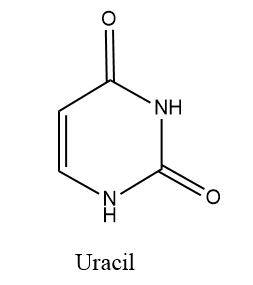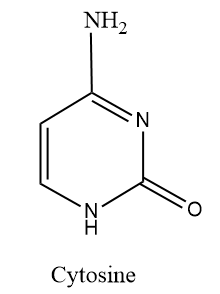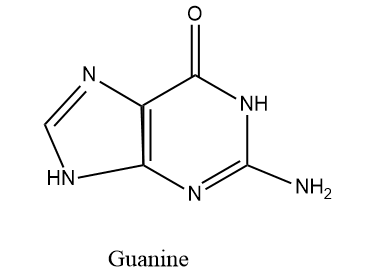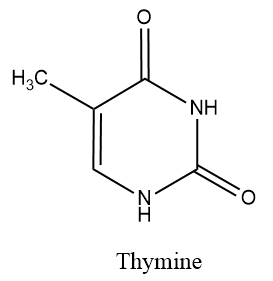
Which base is present in RNA but not in DNA?
A. Uracil
B. Cytosine
C. Guanine
D. Thymine
Answer
430.5k+ views
Hint: The two types of nucleic acids are DNA (deoxyribonucleic acid) and RNA (ribonucleic acid). DNA and RNA are made from nucleotides, each containing a five-carbon sugar, a phosphate group, and a nitrogen base.
Complete answer:
There are 2 types of bases present in DNA and RNA. These are purines and pyrimidines bases. Purines are larger than pyrimidines because they have a two-ring structure whereas pyrimidines have a single ring.
A. Uracil: A nucleobase in which the pyrimidine ring has 2 oxo- groups positioned at 2 and 4. It is a demethylated form of Thymine. Naturally occurring pyrimidine which is found in RNA. Its bases pairs with adenine which is replaced by Thymine in DNA. Uracil has molecular mass 112 grams.
The structure is as follows:

B. Cytosine: Cytosine is a pyrimidine derivative base, with a heterocyclic, aromatic ring, with two substituents attached one, an amine group at positioned 4 and a keto group at positioned 2. It is present in both DNA and RNA. The molecular mass of cytosine is 111 grams. Structure of cytosine is:

C. Guanine: Guanine nucleoside is also called guanosine. It is a derivative of purine, which consists of a fused pyrimidine-imidazole ring system having conjugated double bonds. It is an unsaturated and bicyclic planar molecule. It is present in both RNA and DNA. The molecular mass of guanine is 151 grams. The structure is:

D. Thymine: The IUPAC name of thymine is 5-methyl-1H-pyrimidine-2, 4-Dione. It is a pyrimidine nucleobase, which is present only in DNA. In DNA molecules, bases of Thymine are located on one strand form bonds with adenine bases on opposite strands. . It is replaced by Uracil in RNA. The molecular mass of thymine is 126 grams. The structure of Thymine is:

The correct answer to this question is option A. (Uracil).
Note:
DNA and RNA has three bases in common which are Guanine, Cytosine, and Adenine. The difference is in the fourth base, which can be remembered as RNA- GAUC, (Uracil) and in DNA its – GATC (Thymine). This is how it can be memorized.
Complete answer:
There are 2 types of bases present in DNA and RNA. These are purines and pyrimidines bases. Purines are larger than pyrimidines because they have a two-ring structure whereas pyrimidines have a single ring.
A. Uracil: A nucleobase in which the pyrimidine ring has 2 oxo- groups positioned at 2 and 4. It is a demethylated form of Thymine. Naturally occurring pyrimidine which is found in RNA. Its bases pairs with adenine which is replaced by Thymine in DNA. Uracil has molecular mass 112 grams.
The structure is as follows:

B. Cytosine: Cytosine is a pyrimidine derivative base, with a heterocyclic, aromatic ring, with two substituents attached one, an amine group at positioned 4 and a keto group at positioned 2. It is present in both DNA and RNA. The molecular mass of cytosine is 111 grams. Structure of cytosine is:

C. Guanine: Guanine nucleoside is also called guanosine. It is a derivative of purine, which consists of a fused pyrimidine-imidazole ring system having conjugated double bonds. It is an unsaturated and bicyclic planar molecule. It is present in both RNA and DNA. The molecular mass of guanine is 151 grams. The structure is:

D. Thymine: The IUPAC name of thymine is 5-methyl-1H-pyrimidine-2, 4-Dione. It is a pyrimidine nucleobase, which is present only in DNA. In DNA molecules, bases of Thymine are located on one strand form bonds with adenine bases on opposite strands. . It is replaced by Uracil in RNA. The molecular mass of thymine is 126 grams. The structure of Thymine is:

The correct answer to this question is option A. (Uracil).
Note:
DNA and RNA has three bases in common which are Guanine, Cytosine, and Adenine. The difference is in the fourth base, which can be remembered as RNA- GAUC, (Uracil) and in DNA its – GATC (Thymine). This is how it can be memorized.
Recently Updated Pages
Using the following information to help you answer class 12 chemistry CBSE

Basicity of sulphurous acid and sulphuric acid are

Master Class 12 Economics: Engaging Questions & Answers for Success

Master Class 12 Maths: Engaging Questions & Answers for Success

Master Class 12 Biology: Engaging Questions & Answers for Success

Master Class 12 Physics: Engaging Questions & Answers for Success

Trending doubts
Which are the Top 10 Largest Countries of the World?

Differentiate between homogeneous and heterogeneous class 12 chemistry CBSE

Draw a labelled sketch of the human eye class 12 physics CBSE

What is the Full Form of PVC, PET, HDPE, LDPE, PP and PS ?

What is a transformer Explain the principle construction class 12 physics CBSE

What are the major means of transport Explain each class 12 social science CBSE




